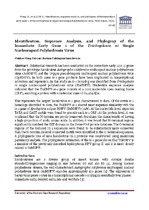| dc.contributor.author | Wang, Weizhou | |
| dc.contributor.author | Leat, Neil | |
| dc.contributor.author | Fielding, Burtram C. | |
| dc.contributor.author | Davison, Sean | |
| dc.date.accessioned | 2013-11-28T10:29:27Z | |
| dc.date.available | 2013-11-28T10:29:27Z | |
| dc.date.issued | 2001 | |
| dc.identifier.citation | Wang, W., et al. (2001). Identification, sequence analysis, and phylogeny of the immediate early gene 1 of the trichoplusia ni single nucleocapsid polyhedrosis virus. Virus Genes, 23(1): 53-62 | en_US |
| dc.identifier.issn | 0920-8569 | |
| dc.identifier.uri | http://hdl.handle.net/10566/881 | |
| dc.description.abstract | Substantial research has been conducted on the immediate early 1 (ie-1) genes from the prototype baculovirus
Autographa californica multicapsid nuclear polyhedrosis virus (AcMNPV) and the Orgyia pseudotsugata
multicapsid nuclear polyhedrosis virus (OpMNPV). In both cases ie-1 gene products have been implicated in transcriptional
activation and repression. In this study an ie-1 homolog was identified from Trichoplusia ni single
nucleocapsid polyhedrosis virus (TniSNPV). Nucleotide sequence analysis indicated that the TniSNPV ie-1 gene
consists of a 2217 nucleotide open reading frame (ORF), encoding a protein with a molecular mass of 84.464 kDa.
This represents the largest baculovirus ie-1 gene characterised to date. Of the seven ie-1 homologs identified to date,
the TniSNPV ie-1 shared most sequence similarity with the ie-1 gene of Spodoptera exigua MNPV (SeMNPV)
(41%). At the nucleotide level, expected TATA and CAGT motifs were found to precede each ie-1 ORF. At the
protein level, it was confirmed that the N-termini are poorly conserved, but share the characteristic of having a
high proportion of acidic amino acids. In addition it was found that N-terminal regions significantly matched the
SET domain in the Swiss-Prot prosite database. The C-terminal regions of the deduced IE-1 sequences were found
to be substantially more conserved than the N-termini. Several conserved motifs were identified in the C-terminal
sequences. A phylogenetic tree of nine baculovirus IE-1 proteins was constructed using maximum parsimony analysis.
The phylogenetic estimation of the ie-1 genes shows that TniSNPV is a member of the previously described
lepidopteran NPV group II and it is most closely related to SeMNPV. | en_US |
| dc.language.iso | en | en_US |
| dc.publisher | Springer Verlag | en_US |
| dc.rights | This is the post-print version of the article published available online at: link.springer.com/content/pdf/10.1023%2FA%3A1011183313021.pdf | |
| dc.subject | Baculovirus | en_US |
| dc.subject | Trichoplusia ni | en_US |
| dc.subject | Immediate early1 gene | en_US |
| dc.subject | Protein analysis | en_US |
| dc.subject | Phylogeny | en_US |
| dc.title | Identification, sequence analysis, and phylogeny of the immediate early gene 1 of the trichoplusia ni single nucleocapsid polyhedrosis virus | en_US |
| dc.type | Article | en_US |
| dc.privacy.showsubmitter | false | |
| dc.status.ispeerreviewed | true | |
| dc.description.accreditation | Web of Science | en_US |

